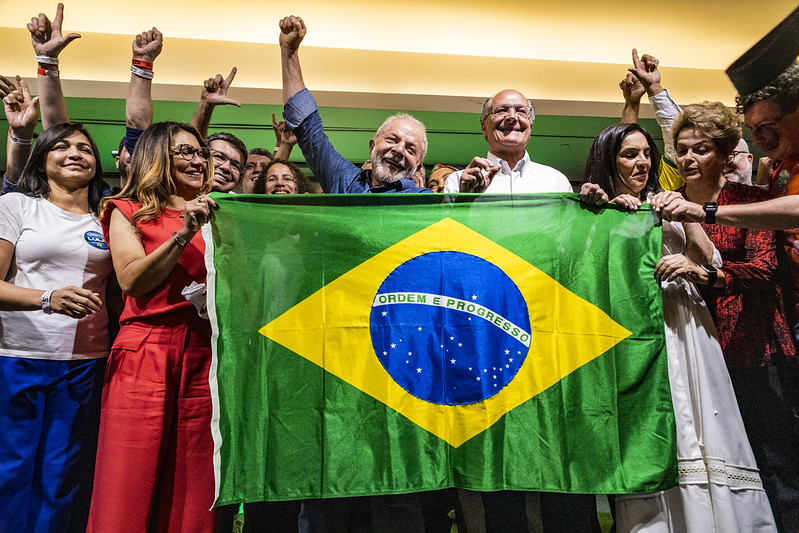The presidential elections are a little over a year away in Brazil, and the campaigns are beginning to heat up. This week, Epoca Magazine announced that the former Minister of the Environment, Marina Silva, is running for president, making the race all the more interesting. Considering Brazil’s role as one of the new economic world powers and diplomatic role in the Americas, a lot is at stake for next year’s candidates. And considering this news bomb hit the U.S. news yesterday, it’s going to be in Americans’ interest to follow the Brazilian election.
Let’s take a look at two of the main candidates, both of whom are women, which could mean one of them could become Brazil’s first female president.
Dilma Rousseff
The candidate from the Worker’s Party (PT), Dilma is President Lula’s choice, and he is already actively supporting her in the race. This has had serious implications in the Sarney crisis, since Lula has refused to push out Sarney, since he needs support for Dilma from Sarney and his political party. Dilma is currently Chief of Staff, Lula’s right-hand woman, helping implement his new social policies (but also helping him with his dirty work).
The daughter of a Bulgarian immigrant and a Brazilian mother, she became a leftist guerrilla during the military dictatorship, fighting with an armed guerilla group, the Vanguarda Armada Revolucionária Palmares. One of the group’s most valued guerrillas, known as the Joan of Arc of subversion, she was the “brains of the operation” in one of the biggest heists in Brazilian history, when the guerrilla group stole US$2.5 million from the Sao Paulo governor, infiltrating his mistress’s home in Rio de Janeiro. She was also a military spy, and helped organize several successful arms robberies from the Brazilian army. She was arrested and tortured in 1970 and was imprisoned for three years.
Later, after she was released, she began a successful political career. In the early 1990s, she became Secretary of Mines and Energy in the state of Rio Grande do Sul, and became the Minister of Mines and Energy for the federal government in 2003. She was appointed Lula’s Chief of Staff in 2005 when her predecessor was booted on corruption charges.
Since then, she has been involved in several scandals. There was the dossier scandal in 2008, when her cabinet supposedly released sensitive financial information about former President Cardoso and his family. There was another scandal in 2008, when she was accused of pressuring Brazilian-owned airline Varig to accept being bought outby several American investors. There was the newer scandal, when a former tax official claims Dilma pressured her not to complete an audit on Senate President Sarney, who has now been accused of a whole host of corruption charges.
Lula is not only rooting for Dilma as his party’s candidate, but in the hopes she will continue his policies. One of his new plans is to reform Petrobras, the state-controlled oil company, and to ensure that it has near total control over the recently discovered oil fields that could make Brazil an even more powerful economic player.
Dilma, however, isn’t exactly a gentle flower. She’s known for her short temper and for even alienating her supporters, getting into fights with other ministers and chewing out government officials. She even made a high-level politician cry–Jose Sergio Gabrielli, the president of Petrobras, during a very rough phone conversation.
Marina Silva
Unlike Dilma, Marina had slightly humbler origins. (Also, in the US she would be considered black, though in Brazil she is considered mixed race.) Born in Acre in a rural slum, her father was a rubber tapper who moved from the Northeast to try his hand during the rubber boom of World War II. Both of her parents were the descendants of slaves and Portuguese immigrants, and had eleven children, eight of whom lived past childhood. When she was 14, Marina began working with her father in the rubber trade; her mother died around that time. She became infected with hepatitis, and moved to the city so she could be treated. There, she began going to school and working as a maid, and decided to become a nun.
Later, she changed her mind, and went to college instead to study history. She was exposed to Marxism, and became an active member of the union movement in the early 1980s. In 1984, she began working with Chico Mendes to found the Central Unica dos Trabalhadores, which went on to become one of the largest unions in the world. She became involved with the Worker’s Party, and ran unsuccessfully for Congresswoman in 1986.
In 1988, she became the city councilor with the most votes ever in Rio Branco, the capital of Acre, where she made many political enemies by reducing perks and financial benefits for city councilors. In 1990, she became a state congresswoman. Shortly after, she discovered that her constant health problems were caused by exposure to dangerous heavy metals while she was a child, forcing her to adhere to a strict diet.
In 1994 at age 35, she was elected as a federal senator, becoming the youngest senator in Brazilian history. She was reelected in 2002, but was named the Minister of the Environment in 2003. Though she had many ambitious projects, she was frustrated by the government’s many frozen environmental projects. Then, she got into a serious tiff with Dilma over environmental licenses; she opposed giving licenses to businesses that would harm the environment, while Dilma was determined to push the projects through in the name of economic development. She resigned in 2008, stating serious impediments in the government to doing her job, and returned to her job as a senator.
Now, she has announced she will run for President as a member of the Green Party, making a very noticable split with the PT after being in the party for her entire political career.

Reply